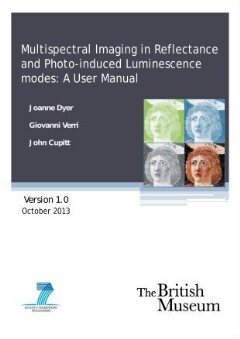Stranica 31 [31]
CHARISM A I 7
li. Photo-induced luminescence images
The factors affecting reproducibility and device dependence of photo-induced emitted
radiation or luminescence images are discussed in the sections below. Four main effects are
considered:
S patial inhomogeneities of the radiation source;
Ambient stray radiation;
Camera response (luminescence calibration);
Pigment-binder effects .
1
2
3
e «ra wma WH
4
Some of these factors are common to both reflected and photo-induced luminescence
images and are discussed only briefly. In addition, correction for some of the above effects
will not be necessary for the three types of luminescence image discussed, e.g. the effect of
colour calibrating the camera response for luminescence is irrelevant to the correction of
visible-induced infrared luminescence images, as these are monochrome. In addition,
although some of the methods discussed could possibly be applied to visible-induced visible
images, the post-processing of this image type is outside the scope of this work.
— Spatial inhomogeneities of the radiation source
In common with reflected images (see above), photo-induced luminescence images must
also be flat-fielded to correct for the spatial inhomogeneities of the radiation source. As
described previously, experimentally this involves recording the distribution of the incoming
radiation on a uniformly reflective board and dividing the reflected image by the distribution
of the radiation in post-processing.
Figure 1-19. (a) UV-induced luminescence image of a detail from a fresco by Agnolo Gaddi taken at
the basilica di Santa Croce in Florence showing inhomogeneous illumination. (b) Image of a uniformly
reflective board taken under the same lighting conditions showing an inhomogeneous distribution of
radiation present at the top and bottom edges of the image. (c) Flat-fielded image appears more even
(© Organic Material in Wall Painting Project, Getty Conservation Institute).
Version No. 1.0 23 Date : 14/10/2013

